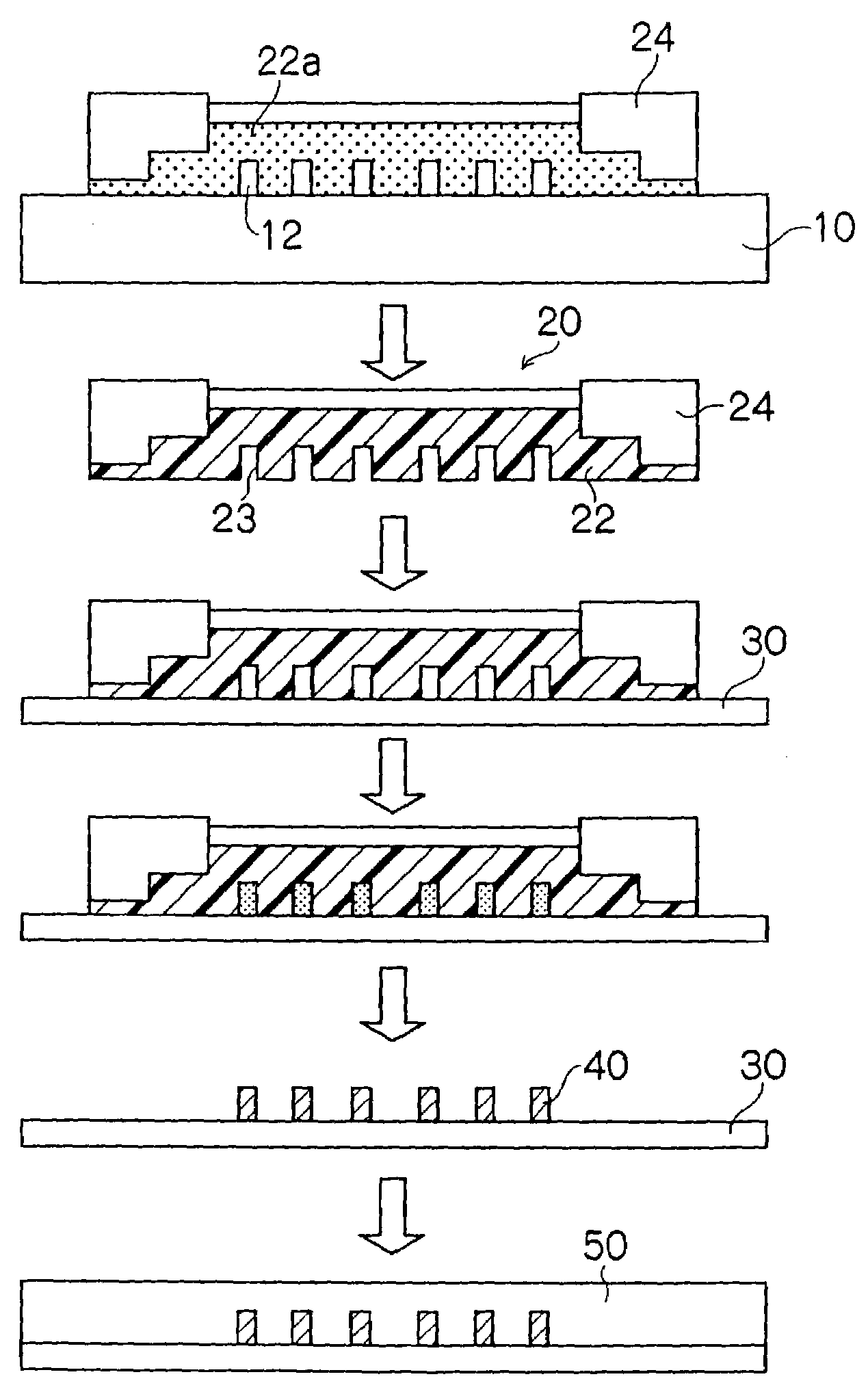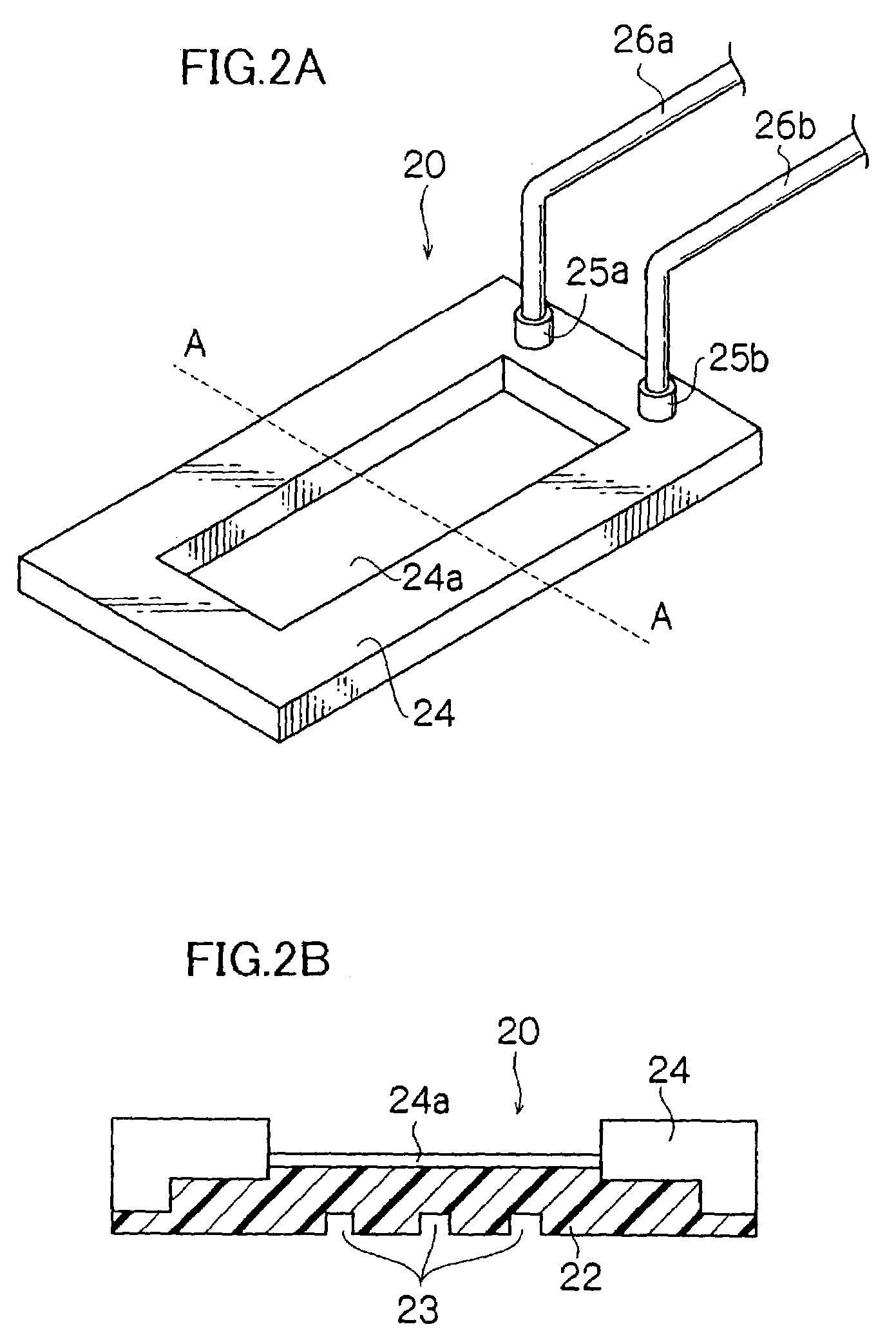Process for producing polymer optical waveguide and resin injecting device
a technology of optical waveguide and resin injection, which is applied in the direction of instruments, optical elements, other domestic objects, etc., can solve the problems of process cost, increase in cost, and inability to provide a sufficient refraction index difference between the core layer, etc., to achieve high precision level, reduce the loss of guided waves, and high productivity
- Summary
- Abstract
- Description
- Claims
- Application Information
AI Technical Summary
Benefits of technology
Problems solved by technology
Method used
Image
Examples
example 1
[0081]An ultraviolet curable thick film resist solution (SU-8, made by MicroChem. Corp.) was applied to a Silicon monocrystal substrate by spin-coating, and then the resultant layer was pre-baked in a heating oven at 80° C. The resultant was exposed through a photo mask to light from a high-pressure mercury lamp, and developed, so as to form a substrate having fine convex portions having a square section (width: 50 μm, height: 50 μm, and length: 60 mm). Next, this was post-baked at 120° C. to form a master template for producing optical waveguide cores.
[0082]Next, a reinforcing member as illustrated in FIGS. 2A and 2B was formed. An opening 24a for light exposure was made of quartz.
[0083]A releasing agent was applied to the master template, and then a thermosetting silicone rubber oligomer (dimethylpolysiloxane SYLGARD 184, made by Dow Corning Asia Ltd.) was applied onto the master template, as illustrated in FIG. 5A. The reinforcing member was pressed onto the silicone rubber oligo...
example 2
[0087]A polymer optical waveguide was produced in the same manner as in Example 1 except that a reinforcing member having injection inlets and air outlets as illustrated in FIG. 4 was used instead of the reinforcing member in Example 1; the internal pressure of the mold (the space V2 in FIG. 5C) was reduced through the pressure-reduction exhaust pipe at the same time when the core-forming curable resin was injected under pressure; an ultraviolet ray-curable resin (made by JSR Corp., refractive index: 1.500) having a viscosity of 500 mPa·s was used as the core-forming curable resin; and the ultraviolet ray-curable resin was cured by UV having an intensity of 75 mW / cm2. The loss of this polymer optical waveguide was 0.41 dB / cm.
example 3
[0088]Using a glass substrate, a master template was formed in the same manner as in Example 1. The same mold as used in Example 2 was formed.
[0089]This mold was brought into close contact with an Arton film (made by JSR Corp., refractive index: 1.510) having a thickness of 188 μm. An ultraviolet ray-curable resin (PJ3001, made by JSR Corp.) having a viscosity of 1300 mPa·s, which was a core-forming curable resin, was injected from the injection pipe to concave portions in the mold under pressure. At this time, the pressure in the concave portions was reduced and the air was removed from the other end of the mold. After the ultraviolet ray-curable resin filled the concave portions in the mold, the injection pipe and the pressure-reduction exhaust pipe were removed from the mold and then UV light having an intensity of 50 mW / cm2 was radiated through the opening for light exposure of the mold onto the resin for 10 minutes, so as to cure the resin in the concave portions. The mold was ...
PUM
| Property | Measurement | Unit |
|---|---|---|
| thickness | aaaaa | aaaaa |
| thickness | aaaaa | aaaaa |
| surface energy | aaaaa | aaaaa |
Abstract
Description
Claims
Application Information
 Login to View More
Login to View More - R&D
- Intellectual Property
- Life Sciences
- Materials
- Tech Scout
- Unparalleled Data Quality
- Higher Quality Content
- 60% Fewer Hallucinations
Browse by: Latest US Patents, China's latest patents, Technical Efficacy Thesaurus, Application Domain, Technology Topic, Popular Technical Reports.
© 2025 PatSnap. All rights reserved.Legal|Privacy policy|Modern Slavery Act Transparency Statement|Sitemap|About US| Contact US: help@patsnap.com



